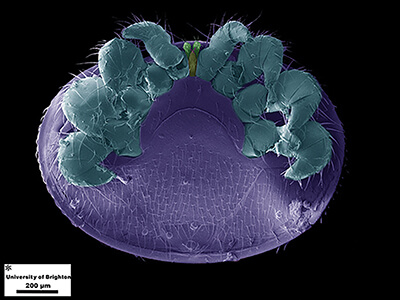
These are new close-up images of one of the mites responsible for killing billions of honey bees around the world.
The magnified photographs of the pinhead-sized mite, aptly named Varroa destructor, were captured by Dr. Jonathan Salvage of the University of Brighton (UK), using a state-of-the-art scanning electron microscope (SEM).
Dr. Salvage, a Research Fellow in the University’s School of Pharmacy and Biomolecular Sciences, has been working with Adam Leitch, a Master Beekeeper, on both a study of plant pollen that honey bees pollinate and aspects of honey bee pest anatomy
Dr. Salvage said: “The mite, with its ice-axe-like weapon of attack, the palptarsi claws, is a major threat to honey bees globally. It is involved in the mass destruction and deaths of billions of bees, which, in turn, threatens crop pollination and food production.”
Mr. Leitch, a member of the Reigate Beekeepers Association, said it was originally thought that blood loss was responsible for the death of parasitised bees: “But scientists later discovered that these bee mites carry and transmit deadly viruses to bees whilst feeding.
“The large red spikes on the claws pierce the body of a victim bee so that the mite can hold on tightly. The mite then feeds on adult bees and larvae using its mouthparts, coloured yellow in Picture 2, like a harpoon to penetrate and secure itself onto the host bee.”
The University has been studying pollen types and morphology associated with honey bees and honey production, to contribute to beekeeper training and education, which Mr Leitch delivers to beekeeping societies.
The mite images will be contributing to the teaching material to furnish amateur beekeepers with the skills to manage mite populations.
There are miticides and non-chemical methods to help combat the mites for beekeepers. Researchers, meanwhile, are studying how ribonucleic acid interference might knock out genes in the mite, and there is also research under way into breeding defensive changes in honey bees.
Dr. Salvage said the £500,000 SEM facility, which provides electron microscopy imaging and analysis, is “proving an invaluable resource for teaching and research which external commercial clients are now benefiting from”.
For more information, contact: KnowledgeExchange@brighton.ac.uk


